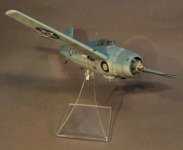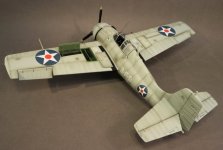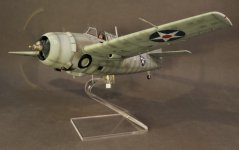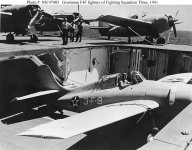NEW RELEASES FOR SEPTEMBER 2018
THE SECOND WORLD WAR
AIRCRAFT CARRIERS

The Grumman F4F Wildcat is an American carrier-based fighter aircraft that began service with both the United States Navy and the British Royal Navy in 1940, where it was initially known by the latter as the Martlet.
The F4F was Grumman’s first monoplane fighter design and was to prove to be one of the great naval fighter aircraft of World War 2.
In 1939 Grumman were successful in obtaining a Navy order for 54 F4F-3’s. The RAF also received 81 F4F-3’s which were named the Martlet I.
The initial deliveries to the US navy were in December 1940, with the first of the planes going to the USS Ranger, and USS Wasp.
These were the only carriers which had the F4F-3’s when war broke out.
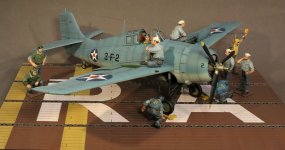
First used in combat by the British in the North Atlantic, the Wildcat was the only effective fighter available to the United States Navy and Marine Corps in the Pacific Theater during the early part of World War II in 1941 and 1942; the disappointing Brewster Buffalo was withdrawn in favor of the Wildcat and replaced as units became available. With a top speed of 318 mph (512 km/h), the Wildcat was outperformed by the faster 331 mph (533 km/h), more maneuverable, and longer-ranged Mitsubishi A6M Zero. However, the F4F's ruggedness, coupled with tactics such as the Thach Weave, resulted in a claimed air combat kill-to-loss ratio of 5.9:1 in 1942 and 6.9:1 for the entire war.
Lessons learned from the Wildcat were later applied to the faster F6F Hellcat. While the Wildcat had better range and maneuverability at low speed, the Hellcat could rely on superior power and high speed performance to outperform the Zero. The Wildcat continued to be built throughout the remainder of the war to serve on escort carriers, where larger and heavier fighters could not be used.
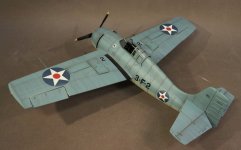
SARA-01
THE SECOND WORLD WAR,
AIRCRAFT CARRIERS,
GRUMMAN F4F-3 WILDCAT,
BuNo3973, FIGHTING SQUADRON THREE(VF-3),
USS SARATOGA (CV-3), OCTOBER 1941
(13pcs)
By late 1941 nearly all of the colourful squadron markings were either gone entirely or existed as quite small examples close by the cockpit area. VF-3’s famous “Felix The Cat” emblem is thus reduced to a 6” diameter circle forward of the cockpit on BuNo 3973.
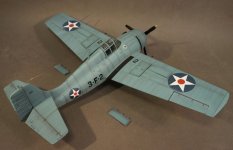

THE SECOND WORLD WAR
AIRCRAFT CARRIERS

The Grumman F4F Wildcat is an American carrier-based fighter aircraft that began service with both the United States Navy and the British Royal Navy in 1940, where it was initially known by the latter as the Martlet.
The F4F was Grumman’s first monoplane fighter design and was to prove to be one of the great naval fighter aircraft of World War 2.
In 1939 Grumman were successful in obtaining a Navy order for 54 F4F-3’s. The RAF also received 81 F4F-3’s which were named the Martlet I.
The initial deliveries to the US navy were in December 1940, with the first of the planes going to the USS Ranger, and USS Wasp.
These were the only carriers which had the F4F-3’s when war broke out.

First used in combat by the British in the North Atlantic, the Wildcat was the only effective fighter available to the United States Navy and Marine Corps in the Pacific Theater during the early part of World War II in 1941 and 1942; the disappointing Brewster Buffalo was withdrawn in favor of the Wildcat and replaced as units became available. With a top speed of 318 mph (512 km/h), the Wildcat was outperformed by the faster 331 mph (533 km/h), more maneuverable, and longer-ranged Mitsubishi A6M Zero. However, the F4F's ruggedness, coupled with tactics such as the Thach Weave, resulted in a claimed air combat kill-to-loss ratio of 5.9:1 in 1942 and 6.9:1 for the entire war.
Lessons learned from the Wildcat were later applied to the faster F6F Hellcat. While the Wildcat had better range and maneuverability at low speed, the Hellcat could rely on superior power and high speed performance to outperform the Zero. The Wildcat continued to be built throughout the remainder of the war to serve on escort carriers, where larger and heavier fighters could not be used.

SARA-01
THE SECOND WORLD WAR,
AIRCRAFT CARRIERS,
GRUMMAN F4F-3 WILDCAT,
BuNo3973, FIGHTING SQUADRON THREE(VF-3),
USS SARATOGA (CV-3), OCTOBER 1941
(13pcs)
By late 1941 nearly all of the colourful squadron markings were either gone entirely or existed as quite small examples close by the cockpit area. VF-3’s famous “Felix The Cat” emblem is thus reduced to a 6” diameter circle forward of the cockpit on BuNo 3973.




